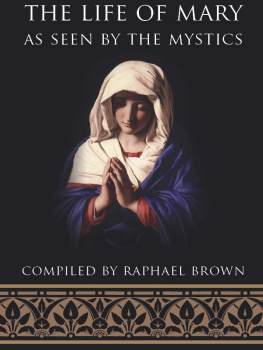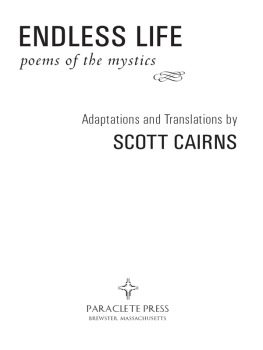Raphael Brown - The Life of Mary As Seen by the Mystics
Here you can read online Raphael Brown - The Life of Mary As Seen by the Mystics full text of the book (entire story) in english for free. Download pdf and epub, get meaning, cover and reviews about this ebook. year: 2011, publisher: TAN Books, genre: Science. Description of the work, (preface) as well as reviews are available. Best literature library LitArk.com created for fans of good reading and offers a wide selection of genres:
Romance novel
Science fiction
Adventure
Detective
Science
History
Home and family
Prose
Art
Politics
Computer
Non-fiction
Religion
Business
Children
Humor
Choose a favorite category and find really read worthwhile books. Enjoy immersion in the world of imagination, feel the emotions of the characters or learn something new for yourself, make an fascinating discovery.
- Book:The Life of Mary As Seen by the Mystics
- Author:
- Publisher:TAN Books
- Genre:
- Year:2011
- Rating:3 / 5
- Favourites:Add to favourites
- Your mark:
- 60
- 1
- 2
- 3
- 4
- 5
The Life of Mary As Seen by the Mystics: summary, description and annotation
We offer to read an annotation, description, summary or preface (depends on what the author of the book "The Life of Mary As Seen by the Mystics" wrote himself). If you haven't found the necessary information about the book — write in the comments, we will try to find it.
The Life of Mary As Seen by the Mystics — read online for free the complete book (whole text) full work
Below is the text of the book, divided by pages. System saving the place of the last page read, allows you to conveniently read the book "The Life of Mary As Seen by the Mystics" online for free, without having to search again every time where you left off. Put a bookmark, and you can go to the page where you finished reading at any time.
Font size:
Interval:
Bookmark:
V EN. M OTHER M ARY OF A GREDA
and V EN. A NNE C ATHERINE E MMERICH
Raphael Brown
Charlotte, North Carolina
Nihil Obstat: | John A. Schulien, S.T.D. |
Censor Librorum | |
Imprimatur: |
|
Archbishop of Milwaukee | |
June 8, 1951 |
The Nihil Obstat and Imprimatur are official declarations that a publication contains no doctrinal or moral error. They are not an endorsement of the content or views expressed.
Copyright 1951 by Gertrude M. Brown.
Retypeset and republished in 1991 by TAN Books and Publishers, Inc. The type in this book is the property of TAN Books and Publishers, Inc., and may not be reproduced, in whole or in part, without written permission of the Publisher. (This restriction applies only to reproduction of this type, not to quotations from the book.)
Library of Congress Catalog Card No.: 90-71852
ISBN: 978-0-89555-436-9
ISBN: 978-0-89555-955-5
ISBN: 089-555-955-2Cover Image: The Madonna, by Giovanni Battista Salvi da Sassoferrato, Wikimedia Commons.Cover design by Milo Persic.
Printed and bound in the United States of America.
Charlotte, North Carolina
1991
who helped
with prayer and counsel.
In conformity with the decrees of Pope Urban VIII concerning the publication of private revelations, I herewith declare that:
1. While the sources from which this book has been compiled have frequently been published with the approval of learned theologians and with the permission of the ordinaries of many dioceses in several countries, I willingly submit all that is contained in this work to the judgment of the Holy See;
2. In applying the terms saint and venerable to persons who are neither canonized nor beatified, I wish in no way to anticipate the final decision of the Church; and
3. For all the private revelations and seemingly supernatural events herein narrated, insofar as they have not received the attestation of the Church, I claim no more than the assent of a merely human credence, according to the dictates of prudence and the principles of mystical theology.
M YSTICISM, especially of the visionary type, has always been a subject of discussion in the Church. Among its manifestations, some few have merited the approval of the prudent, others are looked upon as doubtful, while many have been rejected as false. In certain cases the Church has intervened with a condemnation. Only recently (February 3, 1951) an unofficial but authoritative warning has been uttered by a member of the Roman Curia, Monsignor Alfredo Ottaviani, against the flood of allegedly supernatural events in various parts of the world which tend to substitute a frenzied religiosity for obedience to the Church and reception of the Sacraments.
Even in the case of holy people and when the supernatural character of the phenomena seems sufficiently guaranteed, caution is necessary. The person receiving the favor may not distinguish with enough exactness the period of illumination from that which immediately follows, in which the soul remains in dispositions of the greatest fervor. St. Ignatius Loyola teaches that in this second period it often happens that by its own thoughts, from its own habits, and in consequence of its conceptions and judgments, whether by the suggestion of the good or evil spirit, the soul makes various resolves and plans which are not inspired immediately by God Our Lord. Although the Saint is speaking only of resolves and plans, strong reasons lead us to extend this prudent observation to the content of visions. The imagination working on the memory will inevitably supply details.
Difficulties of terminology, which are common to all technical literature, also play a role in spiritual writings. St. Robert Bellarmines remark still holds good: Writers on mystical theology are usually blamed by some and praised by others because what they say is not understood in the same way by all. The visionaries whose writings are used in this volume were women of no special competence in theology, but they were possessed of some gifts as writers and especially of lively imaginations. Trying to express in concrete terms their supernatural experiences, they had to borrow a vocabulary from books and persons or, if they were capable of it, forge one of their own. In either case they ran considerable risk of not reproducing faithfully the content of their visions.
Despite difficulties which are obvious to all who have had some experience in this thorny field, the Church has never been adverse to the prudent exploitation of the mystical writings of her saintly children. Catholic doctrine on revelation is clear enough to supply the required safeguards. The Church teaches as a revealed dogma that public revelation ceased with the death of the last Apostle, over eighteen hundred years ago. The Deposit of Faith is complete. No further revelation binding all will be forthcoming to the end of time. Even if an angel from heaven were to preach a gospel other than that which we have preached to you, let him be anathema. (Gal. 1:18). Gods revelation in and through His Son is final. The Church which possesses the fullness of this revelation can alone impose beliefs on the faithful at large, and the Church imposes only such as are contained in the Holy Scripture and in divine and apostolic Tradition.
The first law of new revelations is, therefore, that they cannot be really new. They must agree with Holy Scripture and Tradition, with morality and the decisions of the Church. Again, a private revelation will rightly be looked on with suspicion if the person receiving it is not approved by a good life, manifested by irreproachable conduct, by the practice of all the virtues of his state of life and especially by humilityand this before, during and after the favor. Even when satisfied that there is nothing offensive to reason, faith or morals in a revelation and that the character of the recipient is such as to lend probability to the report, and even if the Church should approve, we accept it with a merely human belief. St. Thomas Aquinas remarks that Catholic faith rests upon the revelation made to the Apostles and Prophets who wrote the canonical Scriptures but not on a revelation, if any, made to others. The Church, in approving of mystical phenomena, affirms that there is nothing against faith or morals in the content of the revelations, but does not guarantee their truth. The possibility of error in the facts is not excluded.
Because of this reserve the attitude of Catholics could, and has not failed to, manifest remarkable divergencies. We have Moses and the Prophets, many assert, and we do not require fresh visions and private revelations. Others, on the contrary, read such writings with avidity once competent ecclesiastical authority has sanctioned the publication. In this class are found numerous devout Christians of saintly life. To name but oneMatt Talbot, the Dublin workingman whose solid virtues have greatly edified the Church in our day, was much given to the perusal of this type of spiritual literature. In addition to these two responses to private revelations, there are others which it will not be necessary to specify here.
Font size:
Interval:
Bookmark:
Similar books «The Life of Mary As Seen by the Mystics»
Look at similar books to The Life of Mary As Seen by the Mystics. We have selected literature similar in name and meaning in the hope of providing readers with more options to find new, interesting, not yet read works.
Discussion, reviews of the book The Life of Mary As Seen by the Mystics and just readers' own opinions. Leave your comments, write what you think about the work, its meaning or the main characters. Specify what exactly you liked and what you didn't like, and why you think so.










 Moses E. Kiley
Moses E. Kiley